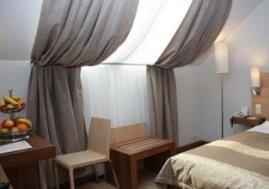In June, foreign demand continued to increase, while domestic demand continued to decrease in public accommodation establishments
In the observed period, due to foreign guests, the number of guests slightly increased. However, on
the whole, the number of tourism nights in public accommodation establishments decreased by
0.5% because of the decline in domestic tourism arrivals. In hotels, tourism arrivals changed more
favourably (increased by 4.1%9, in which four-star units played a determining role. All in all,
public accommodation establishments saw a 5.5% increase in total revenue.

Foreign guests spent 1 069 thousand nights in public accommodation establishments, a 3.2% year-onyear
increase in number and a 1.9% year-on-year increase in nights. Foreigners accounted for 51% and
two thirds of tourism nights and accommodation fees respectively. There was a year-on-year decrease in
the number of nights spent by guests from Romania, Austria, Germany and the United States of America,
while there was an increase in the overnight stays in the case of the United Kingdom, the Czech Republic,
Russia and Italy. In hotels accounting for a considerable part of international arrivals, four star units saw
an increase, while there was stagnation or decrease in all the other categories. The number of international
arrivals decreased in the majority of tourist regions.
In June, domestic guests spent 1 026 thousand tourism nights in public accommodation
establishments, 49% of total tourist arrivals. Year-on-year, a 1.6% decrease was seen in the number of
arrivals and a 3.0% drop in that of tourism nights. Out of the nine tourist regions, seven was affected by
the fall in domestic tourist arrivals. In hotels accounting for more than half of domestic arrivals, the
number of tourism nights increased by 1.8%.
Room occupancy in hotels was 49.8% on average; within this, the occupancy rate was 72.5% in
five-star units and 58.3% in four stars hotels.
In June, there was a 5.0% increase in the gross average room rate (HUF 15,025), while the
revenue per available room in hotels (gross REVPAR) saw a 7.0% year-on-year increase (HUF 7,478). In
Budapest, average room prices in three-five star categories, accounting for a considerable part of arrivals,
were between HUF 10,000 and 38,200 in June, while the revenue per available room in hotels was
between HUF 5,200 and 30,300 corresponding to 34-130 and 18-103 Euros respectively. In international
comparison, hotel room rates are still very low.
In the observed period, the revenues of accommodation establishments saw a 5.5% year-on-year
increase at current prices. In June, public accommodation establishments had total gross revenue of HUF
25.2 billion, within this, accommodation revenues amounted to HUF 14.4 billion. The accommodation,
catering price index stood at 4.9%. The HUF/EUR exchange rate was 294 in June, 27 forints (10%)
weaker than a year earlier.
Among accommodation establishments in operation, in June, 2,222 units accepted holiday vouchers
and 1,774 units Széchenyi vouchers as a means of payment. In this month, service sales to domestic
guests through these voucher schemes amounted to HUF 857 million, out of which holiday vouchers
accounted for 24%.
In Budapest, as a result of a dynamic increase in international arrivals, the number of tourism
arrivals as a whole increased by 5.8%, while the number of domestic tourism nights increased by only
0.7%. In the tourist region of Lake Balaton, the number of both international and domestic tourism nights
fell, on the whole by 3.6%.
In June, accommodation establishments operating in different branches employed directly 31
thousand persons, a 2.5% decrease year-on-year. The proportion of part-time employees in hotels is
different by category; only four- and five-star hotels have a minimal use of temporary staffing services.
Related news
Related news
(HU) Önáltató sörisszák – A nap képe
🎧 Hallgasd a cikket: Lejátszás Szünet Folytatás Leállítás Nyelv: Auto…
Read more >(HU) A nap mondása
🎧 Hallgasd a cikket: Lejátszás Szünet Folytatás Leállítás Nyelv: Auto…
Read more >MBH Analysis Center: Hungarian tourism is soaring – further growth is expected in the hotel market
🎧 Hallgasd a cikket: Lejátszás Szünet Folytatás Leállítás Nyelv: Auto…
Read more >



